How to make a hydrogen generator for your home with your own hands: practical tips for manufacturing and installing
We are used to considering natural gas as the most affordable type of fuel. But it turns out that he has a worthy alternative - hydrogen obtained by splitting water. The starting material for the production of this fuel is generally free of charge. And if you also make a hydrogen generator with your own hands, the savings will be simply amazing. Right?
We are ready to share with you valuable information on options and assembly rules for a technical installation designed for hydrogen production. Studying the article presented to your attention will become a guarantee of manufacturing a faultlessly operating device.
Those who wish to build a generator of cheap, but very productive fuel with their own hands, we offer detailed instructions. We give recommendations for competent operation. As informative additions that clearly explain the principle of action, photo applications and videos were used.
The content of the article:
Hydrogen Production Methods
High school chemistry lessons once gave an explanation on how to get hydrogen from ordinary water flowing from a tap. There is such a thing in the chemical field - electrolysis. It is thanks to electrolysis that it is possible to produce hydrogen.
The simplest hydrogen installation is a kind of tank filled with water. Under the water layer are two plate electrodes. An electric current is supplied to them. Since water is an excellent conductor of electric current, a contact with low resistance is established between the plates.
The current passing through the low water resistance contributes to the formation of a chemical reaction, as a result of which hydrogen is formed.
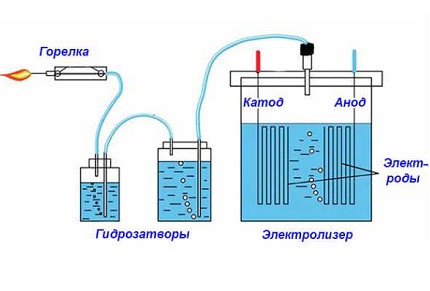
It would seem that everything is simple and quite a bit remains - to collect the formed hydrogen in order to use it as an energy engineer. But in chemistry, it never dispenses with subtle details.
So it is here: if hydrogen combines with oxygen, an explosive mixture is formed at a certain concentration. This moment is one of the critical phenomena that limits the ability to build sufficiently powerful home stations.
Hydrogen generator design
For the construction of hydrogen generators with their own hands, they usually take the classic Brown installation scheme as the basis. Such an average power electrolyzer consists of a group of cells, each of which contains a group of plate electrodes. The power of the installation is determined by the total surface area of the plate electrodes.
Cells are placed inside a tank that is well insulated from the external environment. Pipes for connecting a water line, hydrogen outlet, as well as a contact panel for connecting electricity are displayed on the tank body.

The Brown generator circuit, among other things, provides for a water shutter and a check valve. Due to these elements, the installation is protected against hydrogen return. According to this scheme, the assembly of a hydrogen plant is theoretically possible, for example, for organizing heating of a country house.
Hydrogen heating in the house
Assembling a hydrogen generator for efficient home heating is not a fantastic idea, but obviously extremely unprofitable. In order to get the required amount of hydrogen for a home boiler room, you will need not only a powerful electrolysis unit, but also a significant amount of electrical energy.
Compensation of the consumed electricity with hydrogen obtained at home is seen as an irrational process.

However, attempts to solve the problem of how to make a hydrogen generator for a home with your own hands do not stop. With the principle of operation and the device of one of the models tested in practice hydrogen boiler Introduces the article, which we recommend that you read.
And here is an example of one of the torture options:
- A tight, reliable container is being prepared.
- Tubular or plate electrodes are made.
- A control circuit for operating voltage and current is being assembled.
- Additional modules for the workstation are being made.
- Accessories are selected (hoses, wires, fasteners).
Naturally, you will need a tool kit, including special equipment, for example, an oscilloscope and a frequency meter. Having been equipped with everything necessary, you can proceed directly to the manufacture of a hydrogen heating installation for the home.
Do-it-yourself project implementation
Initially, you need to make a hydrogen generation cell. The fuel cell has overall dimensions slightly smaller than the internal dimensions of the length and width of the generator housing. In height, the size of the block with electrodes is 2/3 of the height of the main body.
The cell can be made of textolite or plexiglass (wall thickness 5-7 mm). For this, five textolite plates are cut in size. Of these, a rectangle is glued (with epoxy glue), the lower part of which remains open.
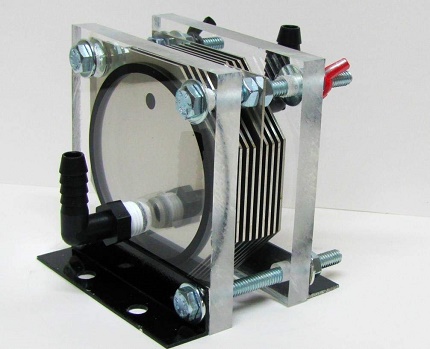
On the upper side of the rectangle, the required number of small holes are drilled for the shanks of the electrode plates, one small hole for the level sensor, plus one hole with a diameter of 10-15 mm for hydrogen output.
Inside the rectangle are placed platinum electrodes, the contact shanks of which are brought out through the holes of the upper plate outside the cell. A water level sensor is installed at 80% of the cell fill. All transitions in a textolite plate (except for the hydrogen output) are filled with epoxy glue.
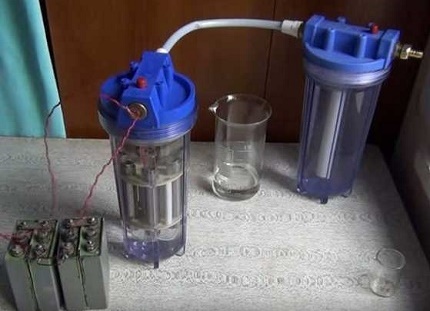
The hydrogen outlet hole must be equipped with a fitting - fix it mechanically, using a seal or glue it. The assembled hydrogen generation cell is placed inside the main body of the device and is carefully sealed along the upper perimeter (again, epoxy can be used).

But before laying the cell inside, the generator housing must be prepared:
- make a supply for water in the bottom area;
- make the top cover with fasteners;
- pick up reliable sealing material;
- place an electrical terminal block on the cover;
- place a hydrogen collector on the cover.
The result should be a partially ready-for-use hydrogen generator after:
- The fuel cell is loaded into the housing.
- The electrodes are connected to the terminal strip of the cover.
- The outlet of hydrogen is connected to a hydrogen collector.
- The cover is mounted on the housing through the seal and secured.
It remains only to connect the water and additional modules.
Additions to the hydrogen generator
A homemade device for producing hydrogen must be supplemented with auxiliary modules. For example, a water supply module, which is functionally integrated with a level sensor installed inside the generator.
In a simple form, such a module is represented by a water pump and a control controller. The pump is controlled by the controller according to the sensor signal, depending on the water level inside the fuel cell.
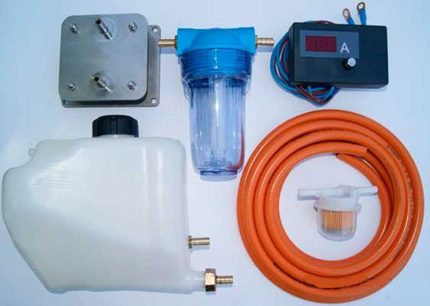
In fact, it is also desirable to have a device that controls the frequency of the electric current and the voltage level applied to the terminals of the working electrodes of the fuel cell. At a minimum, the electrical module must be equipped with a voltage stabilizer and overcurrent protection.
The hydrogen collector, in its simplest form, looks like a tube, where the valve, pressure gauge, check valve. Hydrogen is taken from the collector through a check valve and, in fact, can already be supplied to the consumer.
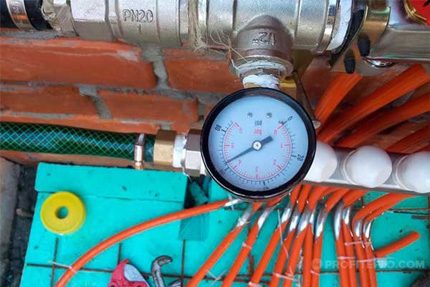
But in practice, everything is somewhat more complicated. Hydrogen is an explosive gas having a high combustion temperature. Therefore, simply taking and pumping hydrogen into the boiler system as fuel - this will not work.
Installation Quality Criteria
It is extremely difficult to assemble a high-quality efficient and productive installation at home. For example, if you even take into account such a criterion as the metal from which the electrode plates or tubes are made, there is already a risk of running into problems.
The durability of the electrodes depends on the type of metal and its properties.You can, of course, use the same stainless steel, but the lifespan of such elements will be short-lived.
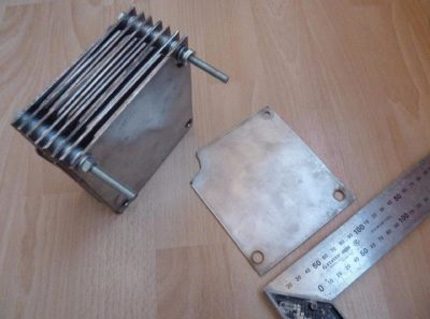
The installation dimensions also play a significant role. Calculations are required with high accuracy in relation to the required power, water quality and other parameters.
So, if the gap between the working electrodes is outside the calculated value, the hydrogen generator may not function at all. In the worst case, the power for which the calculation was made will be several times smaller.
Even the cross section of the wire connecting the electrodes to the power source matters in the device of the hydrogen generator. True, here it concerns the safe operation of the device. Nevertheless, this detail of the design in the home version should be taken into account.
Returning to the safe operation of the system, one should also not forget about the introduction of the so-called water shutter into the design, which prevents the reverse movement of gas.
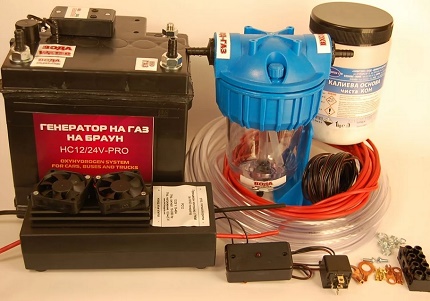
Industrial Generator
At the industrial production level, manufacturing technologies for household hydrogen generators are gradually being mastered and developed. As a rule, power plants of home use are produced, the power of which does not exceed 1 kW.
Such an apparatus is designed to produce hydrogen fuel in a continuous mode of operation for no more than 8 hours. Their main purpose is power supply of heating systems.
Installations for use as part of condominiums are also developed and produced. These are already more powerful structures (5-7 kW), the purpose of which is not only the energy of heating systems, but also the generation of electricity. This combination option is rapidly gaining popularity in Western countries and in Japan.
Combined hydrogen generators are characterized as systems with high efficiency and low emissions of carbon dioxide.
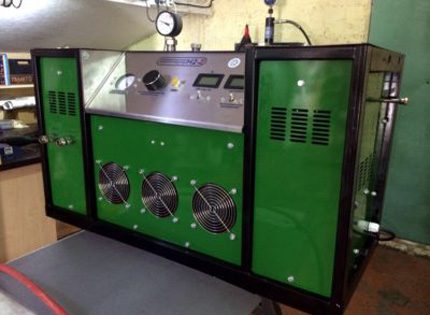
Russian industry also began to engage in this promising type of fuel production. In particular, Norilsk Nickel is mastering the production technology of hydrogen plants, including domestic ones.
It is planned to use a variety of types of fuel cells in the development and production process:
- proton-exchange membrane;
- phosphoric acid;
- proton exchange methanol;
- alkaline;
- solid oxide.
Meanwhile, the electrolysis process is reversible. This fact suggests that it is possible to obtain already heated water without burning hydrogen.
It seems that this is another idea, seizing on which you can launch a new round of passions associated with the free production of fuel for a home boiler.
Conclusions and useful video on the topic
When experimenting at home with home-made models, you need to prepare for the most unexpected results, but negative experience is also an experience:
Do-it-yourself hydrogen generators for the home are still a project that exists at the level of one idea. There are no practically realized projects of hydrogen generators with their own hands, and those that are positioned in the network are imaginations of their authors or purely theoretical options.
So it remains to rely only on an industrial expensive product, which promises to appear in the near future.
Do you know the original model of a hydrogen generator that is not described in the article? Maybe you want to share valuable information that will be useful to home masters? Please write comments in the block below, post a photo on the topic, express your opinion.

 DIY bio-fireplace burner: instructions and manufacturing tips
DIY bio-fireplace burner: instructions and manufacturing tips 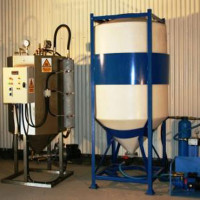 How to make biofuel with your own hands from manure at home
How to make biofuel with your own hands from manure at home  Biofuel for the fireplace: types of biofuel, its properties + how to choose and how to do it yourself
Biofuel for the fireplace: types of biofuel, its properties + how to choose and how to do it yourself  How to make a bio fireplace with your own hands: device, diagrams and step-by-step assembly instructions
How to make a bio fireplace with your own hands: device, diagrams and step-by-step assembly instructions 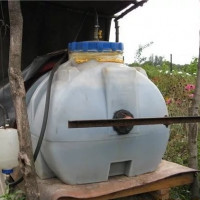 Biogas plant for a private house: recommendations for arranging homemade
Biogas plant for a private house: recommendations for arranging homemade 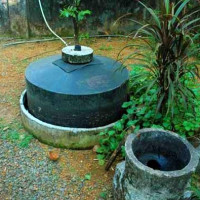 How to get biogas from manure: an overview of the basic principles and design of a production plant
How to get biogas from manure: an overview of the basic principles and design of a production plant  How much does it cost to connect gas to a private house: the price of organizing gas supply
How much does it cost to connect gas to a private house: the price of organizing gas supply  The best washing machines with dryer: model rating and customer tips
The best washing machines with dryer: model rating and customer tips  What is the color temperature of light and the nuances of choosing the temperature of the lamps to suit your needs
What is the color temperature of light and the nuances of choosing the temperature of the lamps to suit your needs  Replacement of a geyser in an apartment: replacement paperwork + basic norms and requirements
Replacement of a geyser in an apartment: replacement paperwork + basic norms and requirements
This method of producing hydrogen fuel by electrolysis of water will be too energy-intensive. I can assure you that methods for producing light, inexpensive and environmentally friendly fuels, such as hydrogen, have long been invented. But for someone it is not profitable. Electric Tesla cars give a little hope, and many are already moving from ICE to electric. Definitely, this is a step in the right direction.
For those who read the article and are interested. Since the 81st year this topic has not left the pages of magazines, newspapers and the Internet. Numerous “authors” publish “their” works, including on YouTube, but I have never seen a complete analysis of such an installation.
Namely:
1. The electrolysis process is based on the law of Faraday (25 Amps) - I have not seen the calculations of the power balance anywhere.
2. I have not seen cooling devices (especially a water shutter) in any published installation.
3. I have never seen a device for relieving excess pressure of a gas mixture in an electrolysis unit.
You can go on, but this is enough to make an obvious conclusion - none of these “authors” have ever used such a device in practice. Unless as an experiment.
When current is applied to the plates (I recall Faraday to 25A), their natural heating occurs. According to theory, heating above 60 ° C is highly undesirable. The higher the current, the greater the heating. How many seconds will a similar device work without cooling? Especially if it is made of plexiglass ... As a result of water electrolysis, steam is released, which passes through the water shutter and is “cleaned” and the exact ratio of 2/1 hydrogen to oxygen is output. I repeat - where is the cooling? What is shown in numerous videos can be called a demonstration model, no more. What they try to “palm off” from enterprises is, at best, consumer deception built on greed.
I completely agree with Gennady and Sergey! Nobody has yet canceled the law of conservation of energy! And if we assume that the efficiency of the electrolysis plant will be 100% (in terms of thermal energy, which in principle cannot be), then the amount of electricity consumed will be equal to the energy (heat) released during the combustion of hydrogen.
Well, those freaks who push all these stupid ideas did not teach definitely elementary physics at school! From myself, I can say that in an electrolytic installation it makes sense only in the form of a high-temperature torch / torch / welding, when acetylene / simple gas-oxygen / electro, etc. etc. for whatever reason, are not desirable or inaccessible. Dot.
Igor, I would like to know - what truth did you teach at school? Do you know that firewood, coal, gasoline, gas are not energy sources and they do not burn? You taught at school that water boils at 100 degrees, right? And what moron told this? Water does not evaporate at 0 degrees? Maybe the kettle’s flame is 100 degrees.Do not assume that everyone is as retarded as you! By the way - hydroelectric power plants are an alternative source of energy ...
I have no words! What kind of freshener did you use (lysergine diethylamide, or simple plaster) before writing about the “kettle flame” ??? Cool! I will share with friends! - Nooooo - of course I don’t know, while the water is boiling at different degrees in the deposits, it looks like a thousand - current degrees are not Fahrenheit, but those that are 40 according to Mendeleev !!! Reread, Vladimir, your message! Dot.
Hello. You seem to have built a very strong logical chain, and even mentioned the school physics program. That is, in your opinion, a hydrogen generator cannot produce more energy than is supplied to it. By the same logic, it turns out that nuclear power plants do not produce more energy than they consume. But everyone knows that this is not so, even those who are not particularly friends with physics.
I am not saying that a hydrogen generator is a great solution for industry or the private sector. But no need to categorically write it off. As for practical experiments, there are craftsman.
The electrolyzer has been working for him for about six months, but there is an urgent problem - the formation of foam. By the way, this video shows how to use the device as a burner. This is really the best option. Much more practical than implementing hydrogen heating. And safer of course!
Your phrase, Amir: “You seem to have built a very strong logical chain and even mentioned the school physics program. That is, in your opinion, a hydrogen generator cannot produce more energy than is supplied to it ”...
YES!!! That is what I affirm! Otherwise, why didn’t you, Amir, and others like them have yet to build the Eternal Engine, or just an engine with an efficiency of more than 100%?
As for what physics I taught at school, I answer Vladimir - ELEMENTARY, and not nuclear. With nuclear, everything is more complicated and interesting, but for home experiments it’s not good at all. Well, there are no (at least for now) portable (pocket) thermonuclear reactors that can extract the difference in bond energies between the simplest hydrogen atoms: deuterium and tritium!
Well, as for the so-called of some “folk craftsmen”, I declare with full responsibility: there is just a hidden sorry “tattoo” for gullible people - additional energy is used in the demonstrations !!! IMHO!